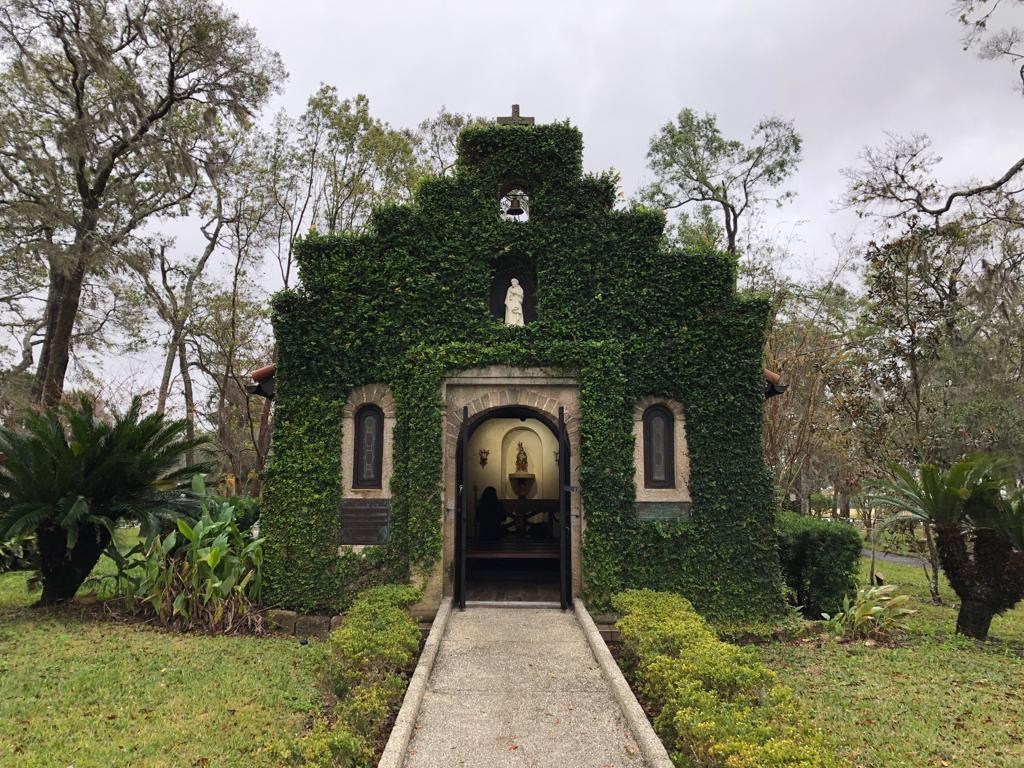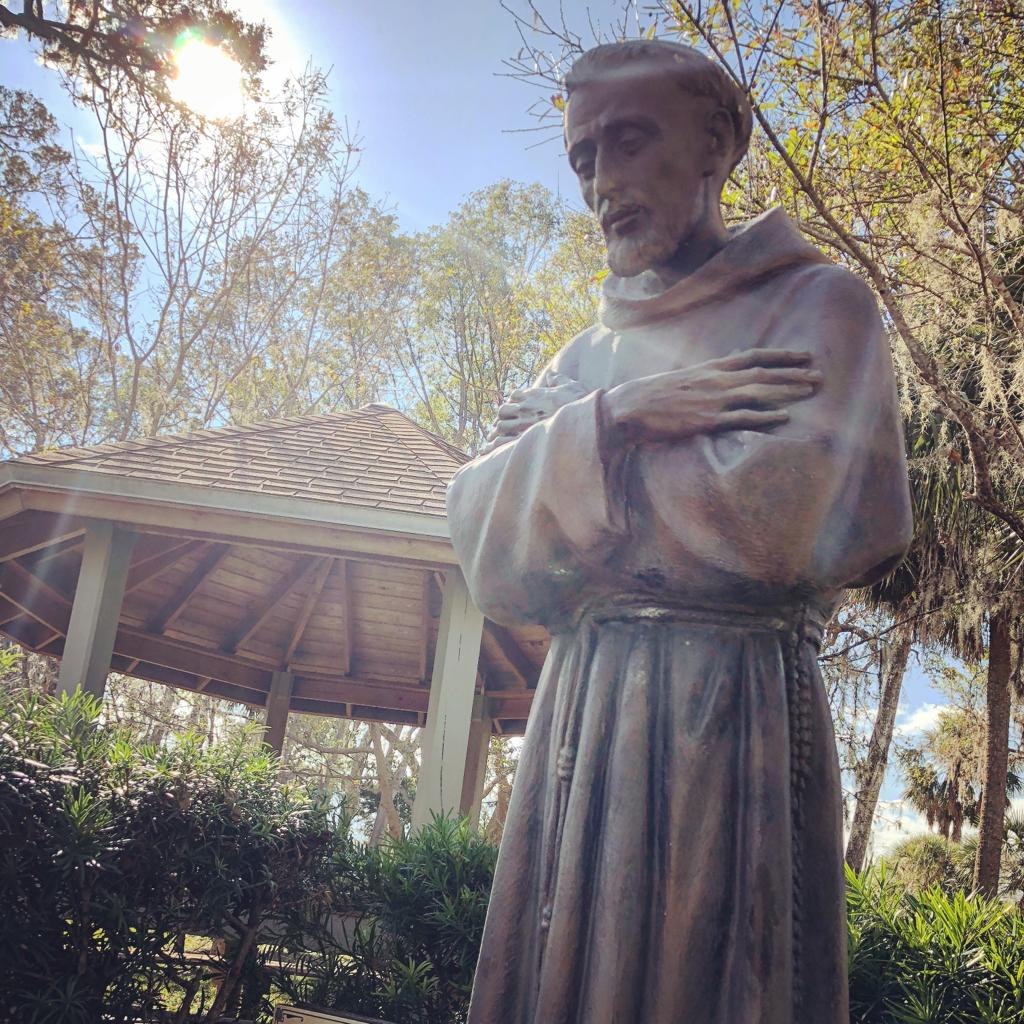Did you know that the first Marian shrine in the United States is located in the same place as many in other “firsts” in the country? These include:
- The first Catholic Mass in the United States
- The first Thanksgiving (hundreds of years before the pilgrims!)
- The first European settlement in the United States
- The first Franciscan mission in the United States
The location? St. Augustine, Florida, home to the Mission Nombre de Dios and Santuario de Nuestra Señora de La Leche y Buen Parto, or, translated in English, the Name of God Mission and the Shrine of Our Lady of Milk (and Happy Delivery).
The devotion was originally established here by Spanish settlers in the 1500s.
And, half a millennia later—on October 11, 2019—the Shrine of Our Lady of La Leche was given even more recognition when Bishop Felipe Estévez of St. Augustine announced that it had been elevated to a national shrine by the U.S. bishops’ conference.
Now it is officially known as Our Lady of La Leche National Shrine.
_______________
HOW IT BEGAN
On September 8, 1565—the feast day of the nativity of the Blessed Virgin Mary—Admiral Pedro Menéndez de Avilés came ashore in what is now part of north-eastern Florida with a group of Spanish settlers. Together they would soon found the city of St. Augustine.
 They also encountered a village of Timucuans, a large tribe of Native Americans who had been living in the area for many generations.
They also encountered a village of Timucuans, a large tribe of Native Americans who had been living in the area for many generations.
Father Francisco López de Mendoza Grajales recorded the day’s events in his diary:
On Saturday the eighth the General landed with many banners spread, to the sounds of trumpets and the salutes of artillery. As I had gone ashore the evening before, I took a cross and went to meet him, singing the hymn ‘Te Deum Laudamus.’ The General, followed by all who accompanied him, marched up to the cross, knelt and kissed it. A large number of Indians watched these proceedings and imitated all that they saw done.
Later, the Spanish shared a meal of thanksgiving with the natives in the same location.
_______________
THE FIRST MASS
Following Menéndez’ veneration of the Cross, thus proclaiming this land in the name of God (Nombre de Dios), Father Lopez celebrated Mass at a rustic altar made of wood.

First the Jesuits and later the Franciscans ministered to the resident Spanish colonists. They made efforts to evangelize the local Mocama and Agua Dulce peoples (Timucuans) near St. Augustine. They were particularly successful in the Mocama village known as Nombre de Dios, converting the chief and her daughter.
Although history paints such “conversions” of Native Americans in a negative light, it is worth noting that the Timucuans are believed to have practiced human sacrifice and inter-tribal warfare as part of their worship of the sun. After converting to Catholicism, however, this all changed.
In 1587, at the beginning of the Franciscans’ first major missionary endeavor into the wilds of the new world, a mission was founded at Nombre de Dios, served by a resident friar.
A formal Franciscan mission was founded near the city in 1587 and was likely the first mission in the continental United States. The mission served nearby villages of the Mocama, a Timucua group which no longer exists due to disease and assimilation with settlers and other tribes.
_______________
OUR LADY ARRIVES
It was also on this sacred ground that the Spanish settlers would begin devotion to Our Lady of La Leche: Mary nursing the infant Jesus. The devotion to Our Lady of La Leche was popular and widespread in Spain in the late 1500s.

The original chapel was destroyed in 1728 during the British siege of St. Augustine and was rebuilt in 1875 by Bishop Augustin Verot, though it later suffered damage from a hurricane. The current ivy-covered chapel, which seats about 30 people, was built in 1914 and is a replica of previous chapels built of coquina rock—a local rock comprised of sand and seashells formed naturally at the seashore.
Many visitors come seeking blessings and intercessions for successful pregnancy and delivery. The centerpiece of the shrine is a statue of the Virgin Mary nursing the infant Jesus, which is a replica of the Our Lady of La Leche statue placed in a cathedral in Spain by Phillip III.
_______________
SHRINE HIGHLIGHTS
These days, the site of all these historic events provides a fascinating glimpse into the rich Catholic history of the United States, not to mention a destination for spiritual enrichment and pilgrimage unlike any other in the world.
Some of the other notable features of the Mission Nombre de Dios shrine include:
The Great Cross – Towering over St. Augustine, the Great Cross was dedicated by Archbishop Casimiro Morcillo to celebrate the 400th anniversary of the founding of the Mission Nombre de Dios. The cross is made of stainless steel and stands 208 feet above the Matanzas marshes.
Museum – The Mission Nombre de Dios Museum features the original casket of the founder of St. Augustine, Pedro Menéndez de Avilés, though his remains are located in Avilés, Spain. The museum’s exhibits also include vestments and chalices from the Diocese of St. Augustine’s archives, and artifacts found during the archaeological excavations of the mission grounds.
Prince of Peace Votive Church – The Prince of Peace Votive Church was constructed in 1965 and is situated at the entrance to the Nombre de Dios Mission grounds. It was built to celebrate the 400th anniversary of the mission’s founding. Prince of Peace is made of coquina and has a large stained glass window depicting a representation of the Holy Spirit.
By taking a short stroll through the Mission’s oak-shaded grounds, you’ll discover even more historical sites and places of prayer that make this American shrine so special. Some favorites include:
- Archaeological excavations
- Historic cemetery
- Marian Shrine to Our Lady of Perpetual Help and
- Marian Shrine to Our Lady of Guadalupe
- A Catholic gift shop,
- Bell tower
- Fountains
- The rustic altar
- Mission plaques and historical markers
- Monuments of the Seven Sorrows of Mary
- Statue of Father López
- Statue of St. Francis of Assissi
- Statue of St. Joseph
If you’ve never visited “our nation’s oldest city,” the Mission Nombre de Dios and Shrine of Our Lady of La Leche are reason enough to plan a trip to St. Augustine. And when you’re done exploring the unique Catholic history of the shrine and taking in all the spiritual graces of your pilgrimage, you won’t want to miss St. Augustine’s historic district, tourist attractions, beaches, and more.
FLORIDA HISTORY NOVEL
Read Sean Bloomfield’s novel The Sound of Many Waters to learn about the Timucuans and their encounters with Spanish conquistadors and Franciscan missionaries.
Available on Kindle and in Paperback – Learn more
MOVIE ABOUT ST. AUGUSTINE PRIEST
Stella Mar Films presents Where There Is Darkness
Having devoted his life to helping the less fortunate, Fr. Rene Robert was regarded as a “living saint” in the tight-knit community of St. Augustine, Florida.
But when Fr. Rene began helping ex-convicts after they’d been released from prison, the people closest to him worried that he was putting his life at risk—especially the local sheriff, David Shoar, one of Fr. Rene’s longtime friends.
So, in April, 2016, when Fr. Rene failed to show up at a church service, Sheriff Shoar immediately put his best detectives on the case and local residents began searching for the beloved priest. It quickly became apparent, however, that Fr. Rene was not just missing—someone had taken him against his will.
True crime documentary WHERE THERE IS DARKNESS follows the nationwide manhunt for Fr. Rene amid a series of shocking revelations and the discovery of a 20-year-old letter in which Fr. Rene seemed to foretell his own fate.







Leave a Reply
You must be logged in to post a comment.